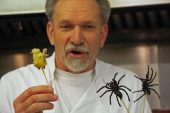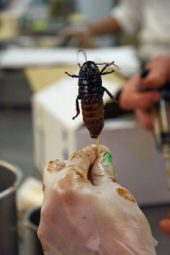Bugs on the menu – The Explorers Club Dinner
Every year, the Explorers Club (the esteemed New York one) holds its annual black-tie fund-raising dinner and cocktail hour at the Waldorf Astoria in New York, featuring its famous array of unusual eats and bug-filled dishes. Just some of the things on the hors d’oeuvres menu that night: Yak Wellington, sweet-and-sour bovine penis, maggot-covered strawberries, scorpions on toast, earthworm stir-fry, mealworm maki, and assorted insect appetizers. It may be about time to launch our African version…. For more read on…
Michael Park was lucky enough to get to hear about the more exotic food experiences some of the Explorers themselves have had during their exploits, and will share. (The Explorers Club’s been around for 105 years, and has an illustrious roster.)
Here are some questions he asked Explorers members.
“What were some of the more frightening or least pleasant meals you’ve had in your travels?”
Lorie Karnath, chairwoman of the Explorers Club Annual Dinner and 37th president of the Explorers Club): “On an early expedition to China in 1979. It was well before the time of the tourist there, and China was not at all prepared for cultural differences in how food is approached. We were traveling in some very rural areas and I tried a dish which tasted like eggplant, as it was quite fried, dark and flat. No one spoke English in the remote region but when I pointed to the food the server made a ‘miaow’ sound to indicate that this was cat.
“Another time was along the China-Mongolian border. We were eating a Mongolian hotpot, mostly different fish dishes. I went to the bathroom, which consisted of a large tub cover which one washed one’s hands [in] and and a less-than-fragrant hole for a toilet. There was no light, but as my eyes adjusted I could see that the tub was writhing … it was filled to the top with black eels … the ones we had just been eating in our hotpot.”
Renate Poeppel, a member of the Berlin chapter: “Uneatable meals on the Maldives in the ’70s, burnt toasts, burnt fish, burnt rice. Without survival packages brought from home, I would have starved.”
Brian Hanson, from Texas : “During 50 years of overseas travels, I have only experienced one upset stomach from what I ate. That occurred one night in 1985 on a flag expedition in the highlands of Papua New Guinea . Dr. Joe Rude and I both ended up with a case of the New Guinea trots and determined it was because our local Highlander cook had spread butter on our bread with his fingers. Apparently butter knives are rare in the Highlands , and the locals never wash their hands! Fortunately, Dr. Rude had some Pepto Bismol tabs handy and they did their job miraculously well. We were both recovered enough the next day to climb Mt. Wilhelm , the highest peak in PNG.”
“What foods have you tried that turned out completely differently than you expected, whether for good or ill?”
Poeppel: “A delicious dinner in Kenya where they served snake, crocodile and all kinds of strange food I would never have ordered voluntarily.”
“What is your most interesting food memory from an Explorers trip?”
Hanson: “On an Explorers Club flag expedition in 1988 with Trammell Crow while studying ethnic tribes in China ‘s Yunnan Province . After a long day’s trek to a Miao village near the Vietnam border, we were tired and very hungry. The villagers were kind enough to bring us a nice pot of soup. I gave the pot a good stir to try to discover the nature of the brew and came up with what appeared to be a buzzard’s foot, claws and all! Our team was of course shocked, but we were also starved and, so, proceeded to devour our ‘vulture’ soup!”
“Was there a particular food that led you to a love of travel? If so, what was it?”
Dr. Christoph von Rohr, of Dusseldorf , and a member of the Western European chapter: “Real Scottish porridge.”
Hanson: “We lived in Taipei on military assignment in the late 1950s. I was just 15, but loved to go down to the Mongolian barbecue on the river. I remember there were always around 12 or 13 meats to choose from that were well-labeled, but, unfortunately, in Mandarin. Since I could only name about six barnyard animals we commonly ate, I always wondered what the other meats were & bat, rat, snake, monkey, water buffalo? I would always choose around six meats, but who knew what they were? It would be fun to bring the very same Mongolian barbecue to America , with the Mandarin labels, of course, and see if it’d fly.”
“What would the earliest members of the Explorers Club think about 21st-century eats?”
Hanson: “I think the early Arctic explorers would absolutely be blown away by the variety of freeze-dried expedition foods available today. They would simply love how they would have lightened their load and enhanced their culinary enjoyment.”
“How do you see food in the U.S. in comparison to the places you’ve visited?”
Karnath: “In many places around the world food is much more seasonal than in the U.S. This is mostly because of opportunity, but in some of the wealthier locations such as Europe , it is also because of a desire to have the freshest foods possible at their peak. Inevitably this can lead to a month of meals with certain kinds of mushrooms, or kale, or strawberries, dependent upon the season, which I think for many in the U.S. who are used to having what they want when they fancy it, might seem at first boring.
“However, as you adapt to nature’s way of providing foods, you start to anticipate trumpet-mushroom month, or curly-kale season after the first frost. It also seems that nature knows when you need certain foods … such as stocking up on iron through kale just before winter sets in. For Americans, they would also start to enjoy ripe, rich red tomatoes that are so meaty you might think you are biting into a steak rather than the fibrous versions we are used to in the grocery store [that are] available year-round.”
“Finally, what is your fondest food memory?”
Robert Aston, of the Museum of Natural History : “Kangaroo fillets cooked over an open fire in the Australian outback.”
Poeppel: “Freshly caught calamari, barbecued on charcoal on a lonely beach on Mayotte ( Comores Islands ).”
A couple interesting facts:
— Each scorpion ends up costing the club $30-plus. Each tarantula ends up costing them around $100.
— The insects, scorpions and spiders are fed diets like farina or cornmeal, fruit and water.
— The economy has struck the Explorers just like everyone else: Tarantulas were smaller this year, and there were fewer exotics in a bid to prevent the wastage of previous years.
— The critters come from privately owned farms throughout the country, where they’re bred and raised as pets, food, etc.
— The guy who heads up the exotics every year is a friendly gentleman by the name of Gene Rurka. He’s the guy in that first pic with the tarantula. He let some of the cooks in the kitchen take home Madagascar hissing cockroaches as pets. (One woman told me she still has a couple living in a plastic box in her home from years past, and calls them “cute.”)
— The chocolate used for the maggot-covered strawberries is Valrhona.
— I like to think I coined the word “bugclava” Saturday afternoon. Try to use it in conversation from now on, please.
— The menu for the actual dinner was much more conventional than the apps: crab and edamame timbale with shaved heart-of-palm salad and roasted-pepper sauce; wild mushroom-stuffed chicken breast with sweet corn risotto, tri-colored cauliflower, baby carrot and pattipans, and candied lemon and micro greens; and triple-chocolate mousse cake with vanilla creme anglaise.
This is the process for tarantula tempura (please don’t try running to the pet store and trying this at home):
This is the process for tarantula tempura:
– Get a live tarantula that’s been kept refrigerated to make it sluggish.
– Stick it in a bowl full of brandy to get it tipsy and make sure the hairs soak in the liquid.
– Put the tarantula on a tray and under a broiler. The hairs, which can be hard to digest, will burn off.
– Skewer the tarantula and stick it in the batter of your choice.
– Deep fry, let rest, enjoy.



